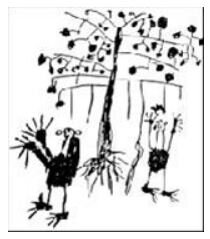
HEALTH EDUCATION STRATEGIES CERTIFICATE
Module 7: Complexities and Realities in Visual Communication
Why Visual Communications Fail
The way people interpret or understand a picture depends on their upbringing, culture, past experiences, and living environment. Though visual communication can be an effective tool for reaching the illiterate, graphics and pictures must be designed with the cultural upbringing of the targeted population in mind. Visual communication often fails because of the disconnect that exists between the designers (oftentimes urban professionals) who create visual messages and the receivers of these messages who are often rural, illiterate villagers.(1) Since urban artists and designers are frequently unaware of exactly how a rural, illiterate villager might perceive a given image, they often fail to convey the desired meaning or message.
The Urban-Rural Discrepancy
A visual aid developed for an urban population could easily be misunderstood by a rural population within the same country because they have different ways of creating and perceiving images. In urban art institutions, artists are taught to draw what they see. In contrast, those who live in rural settings tend to draw what they know. For example, rural people would draw a tree with roots even though the roots cannot be seen. Meanwhile, an urban artist would draw a tree with only the visible parts included. This is an example from Vikalp Design of how a rural person might draw a tree:
Another important difference between urban and rural drawings is that the urban artist is instructed to pay attention to detail, depth, and perspective. However, these elements are unrecognizable to most rural audiences and may only serve to complicate the image. Rural audiences also have difficulty recognizing objects that are superimposed upon one another. Therefore, rural people would draw an object as if it were twisted to include all possible perspectives.(2)
Myth of the Universal Symbol
In western urban societies there are a number of symbols that are considered universal. For example, a red circle with a line running through it, or the letter “x” drawn on top of an object or action, both are understood as “don’t do” or “prohibited”. Though these symbols may seem universal to us, they can easily be misunderstood by people who are unfamiliar with western urban culture. For instance, as Vikalp Design explains, rural women in India interpreted the following graphic in a way that was completely different from its intended message.
Many rural women interpreted the image as being a drawing of an uncovered pot placed behind two crossed sticks, next to a covered pot with a water scoop. The actual health message of the graphic was to cover water storage containers to prevent flies from entering. In this case, the health message of the graphic was completely misunderstood.(3)
Instead of drawing an “x” over an object, rural women in India visualize the message of “stop” or “don’t do” as a hand gesture of two open hands. This is in great contrast to the symbol of the "x" that in many urban cultures symbolizes “don’t do”. The following graphic from Vikalp Design is interpreted by rural villagers as “do not drink and do not do drugs”.
Similarly, speech bubbles that are recognized by many urban children who have grown up reading comics are not understood as speech bubbles by rural youth. Instead, they interpret speech bubbles as clouds or walls.(4) The fact that images can be interpreted in so many different ways shows how important it is for the designer to be aware of the cultural environment, setting, and personal experiences of the targeted audience.
Footnotes
(1) Vikalp Design. "Why Communication Fails." https://www.vikalpdesign.com/communication_fails.html.
(2) Vikalp Design. “Visual Literacy: the urban-rural discrepancy.” http://www.vikalpdesign.com/visual_illiteracy.html.
(3) Vikalp Design. “Common Misinterpretations: Myth of the Universal Symbol.” https://www.vikalpdesign.com/common_mis.html.
(4) Ibid.



